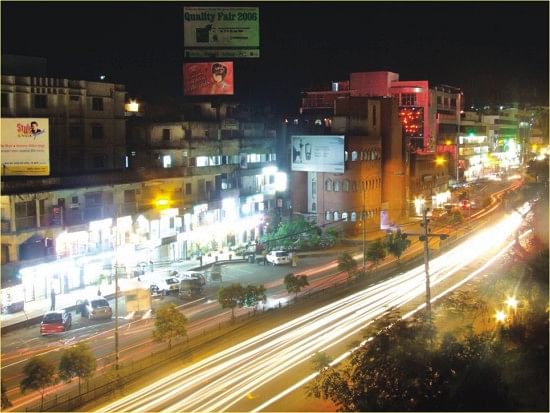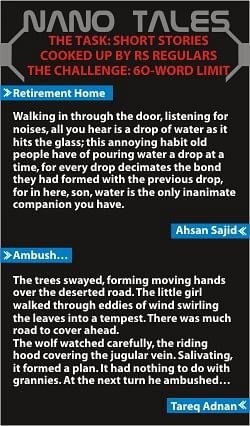

By Nisma Elias
Our dear old Dhaka, a city where 11.9 million live, sleep and dream every single day. Some may be fortunate than the most in actually having the means to make those dreams come true but now we can all proudly say that Dhaka is finally acquiring those things that would allow us to face off any other city in the world; Dhaka is becoming urbanized and that's not necessarily a bad thing.
When someone asks me about what urbanization of our lovable city has bought to our lives the first thing that springs to mind is the choice we have now choices in everything! From boutiques to one stop shop malls, from condiments to restaurants, from entertainment options to cell phone operators, it doesn't stop and all of us are reaping the benefit.
Sania Ahmed, 43, says she remembers way back when there were only two or three good quality restaurants in Dhaka, places where you could eat with the family. 'We used to get so excited at eating at a Chinese restaurant because they were so rare. There is so much more choice now.' It's possible now to yearn for any kind of food - Chinese, Indonesian, Thai, Vietnamese, Mexican, Japanese, Italian, etc and you will get it right here in our city.
What about all the lounges and clubs where the youth hang out nowadays? Places like these couldn't have been dreamed of some decades ago, much less their popularity. D Pavement, PM lounge, X lounge, Decagon Café, Kozmo Lounge and Leisure Lounge are only a few names of places that are slightly expensive but nonetheless popular hangouts. And they're not only for teens either. Older relatives of mine are always asking me to show them what's hot and happening in Dhaka when they come from aboard and a certain blues café is a favourite with one of my uncles. An acquaintance of mine, who came back to Dhaka after about 15 years in the States said jokingly, 'all Dhaka needs is a Starbucks and it'll be just like any other urbanized city.'
One thing that has definitely improved over the years is the communications sector with mobile operators giving a wider coverage. We can also benefit from the number of mobile operators working in Bangladesh by the slash cut rates and a wide array of services. Admittedly this is something that has affected the whole of Bangladesh rather than just Dhaka.
Looking at other sectors, the airport at Dhaka, Zia International Airport, has also improved. I remember always turning up my nose like the brat I was at our airport when I used to come to Dhaka because it just seemed so old and jaded. But now everything in the airport has improved, from the seating area to the runways to the number of aircrafts the airport can handle. As the airport is the first thing a visitor sees in Bangladesh, it is important for it to be functional and presentable.
Added to that are the fabulous 5-star hotels that have sprung up and are springing up to cater to international visitors and important personnel.
Urbanization has just made Dhaka city a more thriving, expanding metropolis. Entertainment options are varied, from movie theaters to amusement parks to rocking music concerts. Educational institutions have increased and while some may be of dubitable standard, there are some fine universities and school in Dhaka. Students have more access to international programs where they get to meet students from other countries and broaden their minds. The internet is now available all over the country and has further helped connect us with the rest of the world. We have all benefited from urbanization one way or the other. It's up to us to see that Dhaka is able to sustain such development and make sure that it happens in a more planned way.

By Sabhanaz Rashid Diya
When my friend, David Clymer (who has come to Bangladesh for a research) requested me to show him around, I jumped at the prospect of introducing our culture to someone through my eyes. However, a few mornings later, when we found ourselves stranded in the middle of Dhanmondi, I realised how bad the idea was. No, he wasn't interested in lounges or oreo frappes; and he was strictly a non-smoker, so I couldn't take him for sheesha. The baggy jeans, remodified Toyotas and hip-hop influenced kids made him laugh, while beggars and poverty weren't exactly what he was looking for. He wanted to meet real Bangladeshis and experience the traditional essence of modern Dhaka.
Sadly, between the glittering malls and unplanned urbanization, there was little of traditional Dhaka left for him to see or taste.
We couldn't find a chanachurwala, screaming “Chanachurrrr!” at the top of his lungs. Apparently, as one of our friends informed us later, chanachurwalas have been banned from Lalmatia as they disrupt the neighbourhood environment. The street food industry seems to be collapsing in competition with the banana splits and pepperoni pizza, since we don't see too many bearded old men selling achaar (pickles) or kulfi ice-cream. It seems they are only available outside school gates when the classes are over for the day. Once the neighbourhood has been cleared of academically burnt-out kids, they seem to disappear until another end-of-classes school ring of the bell on another day. I don't see them stationed at any random location at any time of the day like my sister and I grew up seeing them.
What's even worse, the illustrious chaap pioneer Kader Mama seems to have given up on his fine establishment, as more of his young customers are drawn to the Kozmos and Decagons. The oily and cheap, yet wonderfully delicious tehari we had for lunch between photocopying the class nerd's notes at Nilkhet has lost its characteristic taste and price. The very friendly mama who used to sell the sweetest liquor of tea at the end of my street and re-energise us on any cold, winter evenings is grumpier these days, while his little stall is taken over by a burly chadabaaj and his friends.
Pahela Baishakh is somewhere lost between the white Punjabis and special discounts at overpriced boutiques. It feels that our zeal and traditions abruptly end in front of the TV sets and hanging out with friends at some fast food joint. As a kid, I remember the big mela (fair) and festivities around the Dhaka University campus, and a local mama who brought out his nagordola and gang of helpers every Baishakh. The cheap and excessively pink cotton candy, colourful masks and big rallies seem less attractive to most of us.
The traditional Bangali Illish (Hilsha fish) and pantaabhaat is an offer for a day at Ramna Park, where everybody is fighting over the last shred of their culture for a single day of the year.
Urbanization is a wonderful thing. Every major city across the world needs to have highways, shopping malls, skyscrapers and expensive cars. However, everything good and wonderful comes with a price. For us, it is the nostalgic spirit of yesteryears. Unplanned constructions and fancy Western influences are invading our local essence of life in Dhaka. The Oxford University in UK, which was founded in the 11th Century, has preserved some of its originals walls and structures, even until this day. Yet, they have managed to provide all sorts of modern conveniences for their present day students. In many Italian towns, the old traditional pizzeria and plazas are seen, in tandem with modern shopping malls and five-star hotels. This fine balance of preserving the past and embracing the present is what we so sadly lack in our Dhaka.

